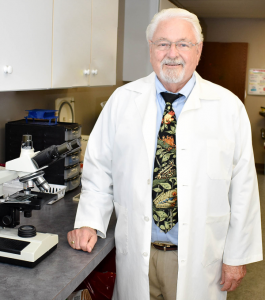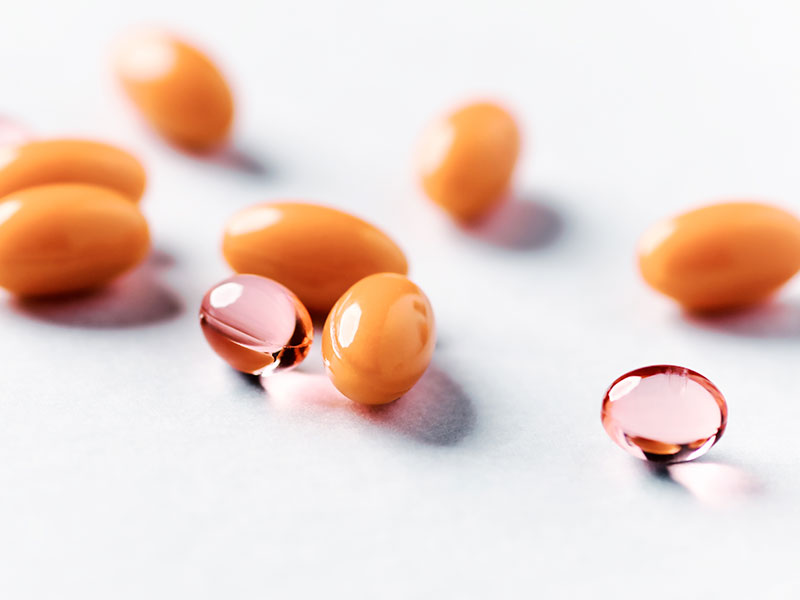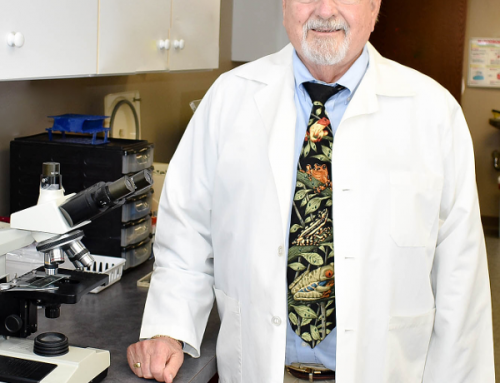On the Web, I see many incorrect and undocumented marketing claims for ubiquinol supplements. As a long-time Coenzyme Q10 researcher, I worry that consumers will be persuaded by these misleading marketing claims. In this article, I want to give some background information about how the Coenzyme Q10 in supplements is absorbed and transferred in the body.
Choice of Two Different Forms of Coenzyme Q10 in Supplements

In 2021, I have published the results of the SIBR Research lab studies and large dog studies of the instability of the ubiquinol supplement. The studies show that the ubiquinol in supplements will be converted to ubiquinone in the small intestines prior to absorption, will then be absorbed in the ubiquinone form, and will be converted back to ubiquinol in the lymph.
Let me start by saying that CoQ10 molecules are redox molecules that have an oxidized form called ubiquinone and a reduced form called ubiquinol. Regardless of whether the supplement manufacturer chooses to work with ubiquinone or ubiquinol, he or she must deal with the following problems [Judy 2018]:
- The CoQ10 raw material is a crystalline powder. Our bodies cannot absorb these CoQ10 crystals. For absorption to occur, the CoQ10 crystals must be broken down to single CoQ10 molecules – not an easy thing to accomplish.
- The manufacturer cannot expect the consumer’s body temperature to dissolve the CoQ10 crystals in the capsule; the melting point of the crystals is considerably higher than human body temperature.
- Even when the CoQ10 crystals dissolve to single molecules, the absorption process is a difficult one. The CoQ10 molecules are lipid-soluble; they need to be incorporated into micelles in order to be transported through the watery environment of the small intestines.
- The CoQ10 molecules are too large to be absorbed directly into the blood. When the micelles deliver them to the intestinal absorption cells – called enterocytes – the CoQ10 molecules have to be absorbed and transferred to the lymph, which then slowly carries them to the blood circulation.
- The large dog studies done by SIBR Research show that ubiquinol from supplements is first converted to the ubiquinone form of Coenzyme Q10 in the small intestines, is absorbed then as ubiquinone, and transfers into the lymph where the Coenzyme Q10 is converted back to the ubiquinol form [Judy 2021 Oct.]. This begs the question: why buy a ubiquinol supplement when the ubiquinol will be converted to ubiquinone prior to absorption?
Ubiquinone
An adequate supply of ubiquinone is essential in the process of ATP energy generation in our cells.
Fact: The ubiquinone form of Coenzyme Q10 is much more stable than the ubiquinol form and much easier to control in the manufacturing process [Judy 2018].
Fact: Supplementation with the ubiquinone form of Coenzyme Q10 has been much more extensively tested in clinical trials, most notably in these randomized controlled trials:
- Q-Symbio Study: Adjuvant therapy of chronic heart failure patients with 3 x 100 mg/day for two years significantly improved symptoms and survival [Mortensen 2014].
- KiSel-10 Study: Combined supplementation of community living senior citizens with 2 x 100 mg/day of Coenzyme Q10 and 2oo mcg/day of selenium for four years significantly reduced mortality from heart disease and improved heart function [Alehagen 2013].
- Gulf War Illness Study: CoQ10 supplementation of veterans diagnosed with Gulf War Illness for 3.5 months significantly improved physical function and general self-rate health [Golomb 2014].
Ubiquinol
Fact: The ubiquinol form of Coenzyme Q10 is an electron donor. As such, it is inherently unstable, always likely to give off two of its electrons and thus be converted to the ubiquinone form of Coenzyme Q10 [Judy 2018].
Fact: It is this property of being an electron donor that makes ubiquinol an important lipid-soluble antioxidant [Judy 2018].
Important to Know About Coenzyme Q10 Supplements
Fact: Both supplement forms – ubiquinone and ubiquinol – have important biological functions in the body. Both are bio-active forms [Littarru 2011].
Fact: However – this is an important point – it is not necessary to take a ubiquinol supplement in order to get enough ubiquinol to act as an antioxidant.
- Mohr, Bowry, & Stocker have shown that a good ubiquinone supplement will increase the level of ubiquinol in the blood and in the blood lipoproteins significantly [Mohr 1992].
- Mantle & Dybring have documented that the body has at least five enzyme systems that effectuate the conversion of ubiquinone to ubiquinol [Mantle & Dybring 2020].
- Moreover, in a head-to-head comparison study, Lopez-Lluch et al have shown that a well-formulated ubiquinone CoQ10 supplement gave a significantly greater absorption and bio-availability than did a patented ubiquinol supplement. Both the ubiquinone supplement and the ubiquinol supplement outperformed a poorly formulated ubiquinol supplement [Lopez-Lluch 2019].
The Lopez-Lluch comparison study shows that the formulation of the CoQ10 supplement is much more important to the absorption and transfer of the substance than is the form of the supplement. Let’s be clear on this – whether the supplement manufacturer uses ubiquinone or ubiquinol is less important for absorption than the heating and cooling process used and the choice of carrier oils in the formulation.
Fact: The outcomes of the Lopez-Lluch study show that not all CoQ10 supplements are equally well absorbed, not even when the different formulations have been manufactured using the same raw material.

In my book summarizing Coenzyme Q10 research, I address many of the misleading marketing claims that are made for the ubiquinol supplements.
Misleading Claims for Ubiquinol Supplements
What are the misleading claims for ubiquinol supplements that I see most often?
Dubious claim: that Coenzyme Q10 in the ubiquinol form is absorbed better than Coenzyme Q10 in the ubiquinone form.
This claim is based on bad science, i.e., based on comparisons of different studies using different patients’ results from different research laboratories, different researchers, and different study protocols [Passwater 2019].
The results from the 2019 Lopez-Lluch head-to-head comparison study, which were results from the same study patients in a cross-over study design, refute this misleading claim [Lopez-Lluch 2019].
Dubious claim: that ubiquinol supplements are necessary to increase plasma ubiquinol concentrations.
As stated above, the work of Mohr, Bowry, and Stocker refutes this claim [Mohr 1992]. Moreover, there are several enzyme systems in the body that facilitate the conversion of ubiquinone to ubiquinol as needed [Mantle & Dybring 2020].
Dubious claim: Ubiquinol is the bio-active form or the more bio-active form.
It is clear that both forms – ubiquinone and ubiquinol – are bio-active forms. It is disingenuous of ubiquinol marketers to imply that ubiquinol is the only bio-active form or that ubiquinol is the only bio-active form.
Dubious claim: Individuals over the age of 40 years need Coenzyme Q10 in the form of ubiquinol.
First of all, the evidence from the best clinical trials conducted with ubiquinone Coenzyme Q10 disproves this claim. In the Q-Symbio study of Coenzyme Q10 adjuvant treatment in patients with chronic heart failure, in the KiSel-10 study of supplementation in senior citizens, and in the Morisco study of adjuvant treatment in patients with congestive heart failure, the average age of the study patients was 63 years, 78 years, and 67 years, respectively. Ubiquinone was used in all of these studies [Mortensen 2014; Alehagen 2013; Morisco 1993].
Secondly, a search of the PubMed database shows that neither the claim itself nor the importance of the age of 40 years is documented.
Dubious claim: Ubiquinol is the water-soluble form of Coenzyme Q10 and thus better suited to transfer through the small intestines.
It may be possible to deliver both ubiquinone and ubiquinol molecules to the small intestine absorption cells enveloped in a hydrophilic complex, but, remember, the CoQ10 molecules themselves are and remain lipid-soluble and are relatively large [Judy 2007].
This claim seems disingenuous as well because 1) water-soluble does not necessarily mean highly absorbed and 2) truly water-soluble molecules would not longer be CoQ10 molecules with Coenzyme Q10’s unique properties.
Conclusions – Absorption of Coenzyme Q10 as Ubiquinone
The SIBR Research lab study and large dog study have shown that orally ingested ubiquinol will be oxidized to the ubiquinone form of Coenzyme Q10 before the ubiquinol from the supplement reaches the intestinal absorption cells. That means that Coenzyme Q10 ingested in the ubiquinol form will be absorbed as ubiquinone and then reduced back to its ubiquinol form.
The current CoQ10 research literature points to the following conclusions:
1) Both forms of Coenzyme Q10 are bio-active.
2) Absorption and bio-availability are more dependent upon the formulation of the CoQ10 supplement than upon on the form of Coenzyme Q10 used, i.e., whether in the ubiquinol or ubiquinone form.
3) A well-formulated ubiquinone supplement will significantly increase the concentration of ubiquinol in the plasma and in lipoproteins.
4) There is no evidence that individuals older than age 40 years must take a ubiquinol supplement.
5) It is misleading to suggest that ubiquinol is the water-soluble form of Coenzyme Q10.
Sources
Alehagen U, Johansson P, Björnstedt M, Rosén A, Dahlström U. Cardiovascular mortality and N-terminal-proBNP reduced after combined selenium and coenzyme Q10 supplementation: a 5-year prospective randomized double-blind placebo-controlled trial among elderly Swedish citizens. Int J Cardiol. 2013;167(5):1860-1866.
Judy WV, Stogsdill WW, Judy DS, Judy JS. Coenzyme Q10 Facts or Fabrications. Natural Products Insider. Natural Products Insider, Virgo Publishing, October, 2007.
Judy WV. Coenzyme Q10: The Substances That Powers Life, An Insider’s Guide. Haderslev, Denmark: Ny Videnskab. 2018; pp. 35-37. ISBN: 978-87-7776-186-7.
Judy WV. The Instability of the Lipid-Soluble Antioxidant Ubiquinol: Part 1-Lab Studies. Integr Med (Encinitas). 2021 Aug;20(4):24-28.
Judy WV. The Instability of the Lipid-Soluble Antioxidant Ubiquinol: Part 2-Dog Studies. Integr Med (Encinitas). 2021 Oct;20(5):26-30.
Judy WV. The Instability of the Lipid-Soluble Antioxidant Ubiquinol: Part 3-Misleading Marketing Claims. Integr Med (Encinitas). 2021 Dec;20(6):24-28.
Littarru , Lamprechts P. Coenzyme Q10: multiple benefits in one ingredient. OCL. 2011;18(2):76-82.
López‐Lluch G, Del Pozo‐Cruz J, Sánchez‐Cuesta A, Cortés‐Rodríguez AB, Navas P. Bioavailability of Coenzyme Q10 supplements depends on carrier lipids and solubilization. Nutrition. 2019;57:133-140.
Mantle D, Dybring A. Bioavailability of Coenzyme Q10: an overview of the absorption process and subsequent metabolism. Antioxidants. 2020;9:386.
Morisco C, Trimarco B, Condorelli M. Effect of Coenzyme Q10 therapy in patients with congestive heart failure: a long-term multi-center randomized study. Clin Investigator. 1993;71:S134-S136.
Mortensen SA, Rosenfeldt F, Kumar A, et al. The effect of coenzyme Q10 on morbidity and mortality in chronic heart failure: results from Q-SYMBIO: a randomized double-blind trial. JACC Heart Fail. 2014;2(6):641-649.
Passwater RA. Coenzyme Q10: research confirms ubiquinone and ubiquinol are nearly equally-absorbed compounds. the physical form and companion ingredients make the bioavailability and absorption difference in Coenzyme Q10 supplements. Part 2: The absorption of ubiquinone and ubiquinol forms of Coenzyme Q10. WholeFoods Magazine. 2019, March 20. https://wholefoodsmagazine.com/columns/vitamin-connection/coenzyme-q10-research-confirms-ubiquinone-and-ubiquinol-are-nearly-equally-absorbedcompounds-the-physical-form-and-companion-ingredients-make-thebioavailability-and-absorption-difference-in-coenz-2/. Accessed 8 February 2022.
The information presented in this review article is not intended as medical advice and should not be used as such.
28 February 2022









Leave A Comment